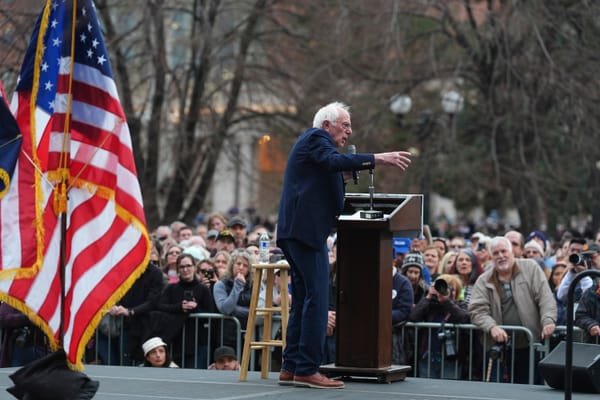The one bright spot for Democrats these days, it seems, is Bernie Sanders. It is an indication of the party’s sad state that the only figure aligned with it who is able to draw big crowds is a nominal independent long viewed suspiciously by the establishment. As party leaders struggle to hone their messaging against Donald Trump, the 83-year-old Sanders, who has never been much for poll-testing slogans, has been barnstorming America, drawing many thousands of people to each of his rallies against oligarchy. The attendance at one Denver rally, according to Team Sanders, topped 30,000. The only other politician who can do numbers like that in America today is Trump.
“He represents an economic populist path Democrats failed to take.”
Part of it is that Sanders, who rarely overthinks his political moves, is the only Democratic-aligned politician in America who is willing to stage rallies in a period when the party is still reeling from its defeat last year. Trump won, people were upset, and Sanders hit the road, bringing out the national following he gained from his two presidential runs, plus others frustrated by the non-confrontational approach taken by the party leadership.
Some of it can also be explained by the unstinting nature of Sanders’s message, which has gained new resonance in the second Trump term. With Elon Musk’s DOGE now setting its sights on Social Security under the guise of cutting “fraud and waste,” Sanders’s longstanding attacks on the excessive political influence of billionaires and his defense of the welfare state seem more relevant than ever. The Vermont senator also never backed some of the progressive left’s more alienating enthusiasms, like open borders or defunding and abolishing the police. All in all, he represents an economic populist path Democrats failed to take over the past decade.
Judging by the current concerns of the party’s elite base of support, that looks unlikely to change. While Sanders has been rabble-rousing, the liberal intelligentsia has been debating Abundance, the new book by the star New York Times columnist and podcaster Ezra Klein and the longtime Atlantic writer Derek Thompson. Klein and Thompson, to be clear, aren’t against taxing billionaires and expanding the welfare state, but they aren’t animated by the issues that have defined Sanders’ career. Instead, they’re focused on administrative burdens and zoning reform.
Construction costs too much in America, they argue, and we don’t build like we used to. We aren’t innovating enough, either. There’s too much risk aversion in science funding and too many strictures placed on researchers. For all our wealth and land bounty, Americans aren’t the global leaders we were when we invented the internet and put a man on the moon.
Most of these arguments are fine, even true. As someone who has written positively about the legacy of Robert Moses, I believe federal and local governments must start to take public infrastructure seriously again. It’s deeply distressing to think about all the parks, bridges, highways, and public housing we were once able to build, and how sclerotic we’ve become since then. Republicans talk tough about China, but don’t care enough that our greatest geopolitical rival is far more capable of throwing up gleaming cities and new rail lines. For their part, Democrats, who control almost every major city, have no grand urbanist agenda at all. This is, in part, what Klein and Thompson are attempting to supply when they suggest Democrats should campaign on and build their public arguments around “abundance.”
Abundance would turn out a crowd at the Aspen Ideas Festival, but not one like Sanders attracted in Denver. It also won’t galvanize the type of grassroots support that still races Sanders’s way, even though he’s too old to run for president again and still lacks a clear successor. The millions of Democrats who are alarmed by Trump’s reckless attacks on the federal government and attempted deportations of green-card holders might nod along, politely, at an abundance confab, but they aren’t going to take to the streets to cry out about the need to legalize accessory dwelling units.
Nor will this agenda bring back most of the voters the party has been losing. The overriding problem for the Democratic Party now is that the American working class has been deserting them for three successive presidential cycles. After 2016, Democrats could shrug and say it was those dastardly whites—all they needed was a little re-education, or maybe they could just be discounted given their declining share of the population. Then, in 2020, Latinos swung right. The last election showed a rightward swerve for virtually every group except college-educated whites—who will undoubtedly be the chief audience for Abundance. If the United States really was Westchester County and Oakland County, that wouldn’t be a problem.
How to get the rural voter to care about abundance? Or the socially conservative Latinos and black voters who supported Barack Obama twice and now consider themselves MAGA? Many of those who pulled the lever for Trump likely feel viscerally that the American dream is slipping out of their grasp, for the reasons Klein and Thompson document. But long-term strategies for housing growth and scientific innovation are less exciting than immediate material goods, like making health care cheaper or bringing down the price of groceries.
The challenge for Democrats is that they’ve been perceived, over the last decade, as the faculty-lounge party. Sanders offered an antidote, but even his rallies now are little more than feel-good affairs: He has limited power in the Senate minority, and there’s no satisfying call-to-action attached to them. That said, he at least still understands how to get ordinary people to care about politics. That is in part because he knows how to name the enemy: a rapacious billionaire class that has driven income inequality skyward. That’s something the rest of them have yet to figure out. Abundance isn’t enough.
